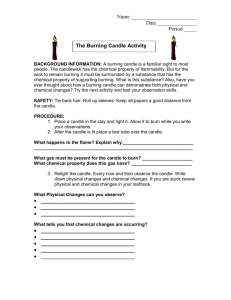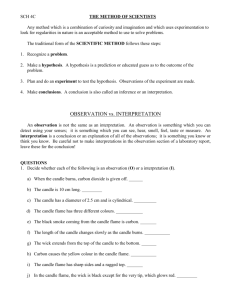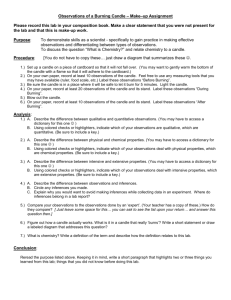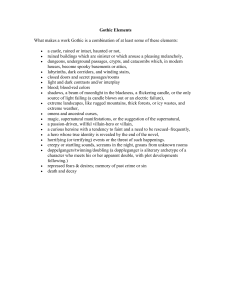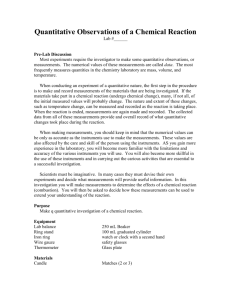Qualitative and Quantitative Observations of a Chemical Reaction
advertisement
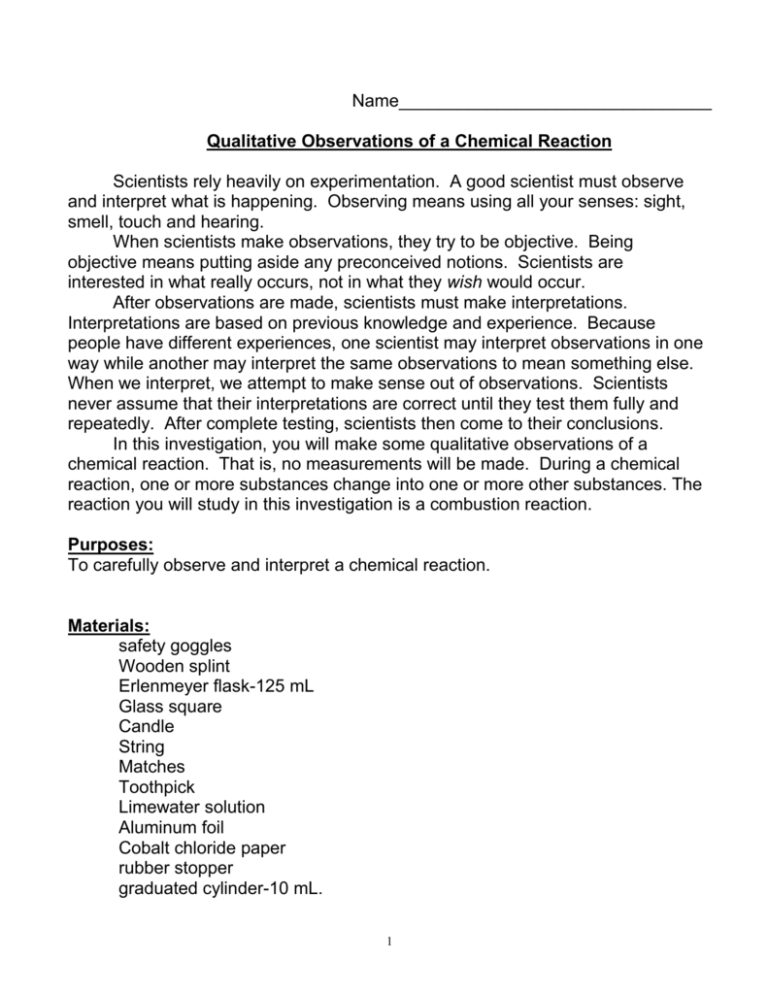
Name________________________________ Qualitative Observations of a Chemical Reaction Scientists rely heavily on experimentation. A good scientist must observe and interpret what is happening. Observing means using all your senses: sight, smell, touch and hearing. When scientists make observations, they try to be objective. Being objective means putting aside any preconceived notions. Scientists are interested in what really occurs, not in what they wish would occur. After observations are made, scientists must make interpretations. Interpretations are based on previous knowledge and experience. Because people have different experiences, one scientist may interpret observations in one way while another may interpret the same observations to mean something else. When we interpret, we attempt to make sense out of observations. Scientists never assume that their interpretations are correct until they test them fully and repeatedly. After complete testing, scientists then come to their conclusions. In this investigation, you will make some qualitative observations of a chemical reaction. That is, no measurements will be made. During a chemical reaction, one or more substances change into one or more other substances. The reaction you will study in this investigation is a combustion reaction. Purposes: To carefully observe and interpret a chemical reaction. Materials: safety goggles Wooden splint Erlenmeyer flask-125 mL Glass square Candle String Matches Toothpick Limewater solution Aluminum foil Cobalt chloride paper rubber stopper graduated cylinder-10 mL. 1 Procedure: Record observations for EACH step in the table below 1. Note appearance, odor, and feel of the unlit candle and record at least 5 observations in Table 1. 2. Heat the bottom of the candle and secure it to a glass square. Light the candle and allow it to burn for several minutes. Note any changes. Briefly describe the burning candle and record at least 5 observations in Table 1. 3. Blow out the flame and immediately place a lit match into the “smoke” about 2 cm above the wick. Record the result in Table 1. 4. Use a wooden splint to transfer a small amount of liquid wax from the top of the candle onto a glass plate. 5. Try to light this with a match and record the result in Table 1. 6. Place a toothpick into the soft candle next to the unlit wick to form a wooden wick. Light the toothpick and record the result in Table 1. 7. Place a length of string about 4 cm long on the glass square. Light it and observe its behavior. Record result in Table 1. 8. Make a slit in a small piece of aluminum foil. Light the candle. Place the foil between the base of the flame and the liquid in the candle bowl. Note the behavior of the flame in Table 1. 9. Pour about 10 mL of clear limewater into a 10 mL graduated cylinder and set this aside until the next step. Goggles are absolutely necessary. 10. Invert a 125 ml Erlenmeyer flask over the lighted candle for several minutes to collect as much candle “smoke” as you can. Remove the flask, turn it right side up, and pour in the clear limewater solution. Stopper and swirl the flask. Record any change in the limewater solution in Table 1. 11. Place a 400 mL beaker over the flame to collect some of the product. Rub a piece of cobalt chloride paper on the inside of the beaker. Record the result in Table 1. 2 TABLE 1: _________________________________________________________________ Unlit candle Lit candle Lit match in smoke Wax on glass Toothpick String Aluminum foil Limewater Cobalt chloride paper 3 Questions (answers to these will be typed in FULL SENTENCES: 1. What phases (solid, liquid, gas) are present in the unlit candle? 2. What phases are present In the burning candle? 3. What part does the wick play in the burning of the candle? 4. What properties should the wick have? 5. Explain the result when aluminum is placed between the liquid and the wick. 6. Is the wick part of the chemical reaction? Relate this to your results from step 7 with the string. 7. What product is indicated by the cobalt chloride paper? What is the resulting color of the paper when that substance is present? 8. What product is indicated by limewater? What happens to limewater when that substance is present? 9. Is it possible that other substances are produced when the candle burns? Explain. 10. A source of energy is needed to start the burning of the candle. What energy source is used? 11. Did the reaction of the burning candle give off or absorb heat? Conclusion: Describe reactants and products of a burning candle, telling how you knew each product was produced. Look up the chemical composition for wax and include was as a reactant. 4



